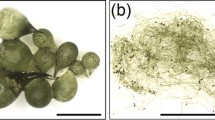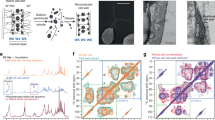Abstract.
The unicellular green alga Chlamydomonas monoica Strehlow is known to produce zygospores with a cell wall that is resistant against microbial and chemical attack. This resistance is thought to be due to the presence of a sporopollenin-like material. However, the resistant nature of sporopollenin-like materials seriously hampers their structural analysis. With complementary techniques such as 13C-nuclear magnetic resonance spectroscopy, Curie-point pyrolysis-gas chromatography/mass spectroscopy and RuO4 chemical degradation, the chemical composition of resistant biopolymer in the isolated cell walls of C. monoica zygospores was determined. This material is composed of C22–C30 linear alcohols and carboxylic acids, intermolecularly linked via ester and ether-linkages similar to the resistant aliphatic biopolymers encountered in the walls of the vegetative cells of the algae Tetraedron minimum, Scenedesmus communis and Pediastrum boryanum.
Similar content being viewed by others
Author information
Authors and Affiliations
Additional information
Received: 29 April 1998 / Accepted: 2 October 1998
Rights and permissions
About this article
Cite this article
Blokker, P., Schouten, S., de Leeuw, J. et al. Molecular structure of the resistant biopolymer in zygospore cell walls of Chlamydomonas monoica . Planta 207, 539–543 (1999). https://doi.org/10.1007/s004250050515
Issue Date:
DOI: https://doi.org/10.1007/s004250050515




